What’s New in Robotics? 10.12.2021

Posted on Dec 10, 2021 10:51 AM. 8 min read time
News briefs for the week take a look at goods-to-robot fulfillment—the Nimble Robotics way, waiter robots in a war-torn city, realism taking hold in the faces of humanoid robots, Google’s robots learn to do chores, advantages of drones with birds’ feet, and microrobots fighting cancer.

What’s the best “automation” combination?
With retailers under pressure for ultrafast fulfillment of their ecommerce needs, what’s the best automation combination for them to pursue for optimal results? Should they buy, rent, or lease automation robotics; or should they hire more and more people…in a market where quality staff are very difficult to find and recruit?
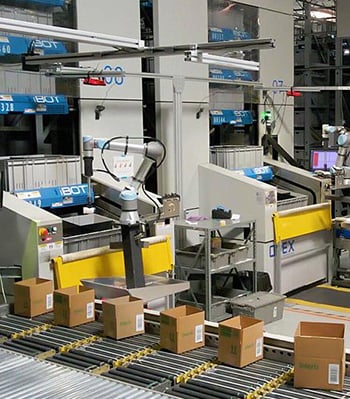 San Francisco-based Nimble Robotics offers a goods-to-robot pick n’ pack solution with retail customers paying per pick. What the company calls: Reimagining fulfillment with intelligent robots that can pick and pack anything.”
San Francisco-based Nimble Robotics offers a goods-to-robot pick n’ pack solution with retail customers paying per pick. What the company calls: Reimagining fulfillment with intelligent robots that can pick and pack anything.”
The company claims that its subscription model and hybrid robot pickers and remote human operators make for an ideal automation combination. The customer pays per pick, and the remote human operators help the robots to learn the 10% of products that they don’t already know.
Nimble's robots, while deployed in a warehouse, also have human remote operators available to temporarily assist with unexpected obstacles, as the warehouse robots go from 90% to full automation.
"We use an algorithm called imitation learning, says Simon Kalouche, Nimble’s founder and CEO, “where you use a human to remotely operate a robot to accomplish a certain task. If you do this hundreds or thousands of times over various tasks, you can train a neural network to say, 'I've seen this and I know how to pick it up.'"
War-torn city restaurant hires robot waiters
 Robot waiters and cooks are popping up most everywhere these days. Even in war-ravaged Iraq service robots are beginning to show up in at least one restaurant. The White Fox restaurant, in the northern city of Mosul, the site of a city-rocking battle to dislodge ISS occupiers in 2017, now sports two robot waiters.
Robot waiters and cooks are popping up most everywhere these days. Even in war-ravaged Iraq service robots are beginning to show up in at least one restaurant. The White Fox restaurant, in the northern city of Mosul, the site of a city-rocking battle to dislodge ISS occupiers in 2017, now sports two robot waiters.
"On television, you see robots and touch-screen tables in the United Arab Emirates, Spain 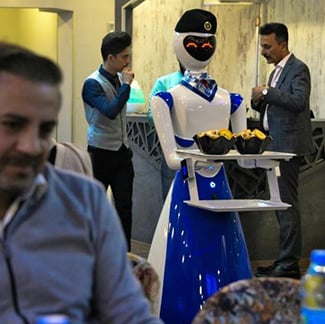 and Japan," said Rami Chkib Abdelrahman, a dentist by profession, owner of the White Fox, which opened in June (2021). "I'm trying to bring these ideas here to Mosul."
and Japan," said Rami Chkib Abdelrahman, a dentist by profession, owner of the White Fox, which opened in June (2021). "I'm trying to bring these ideas here to Mosul."
Abdelrahman contracted with the University of Mosul's department of mechatronics to set up the robot waiters, including the 15 touch-screen tables with built-in menus. “The robots are imported,” explained Abdelrahman, without naming the vendor.
Dinner patrons, Bashar Mahmud and his wife, enjoyed the new robots: "I've traveled abroad and I've never seen anything like this, not in Turkey, Jordan or Saudi Arabia,” said the 50-year-old blacksmith, obviously proud of Mosul’s new-found technology.
Is this the future face of humanoids?
You be the judge. Ameca, a new robot from UK-based Engineered Arts, is said to be a robot with “what appears to be the most human-like facial expressions by a robot to date.”
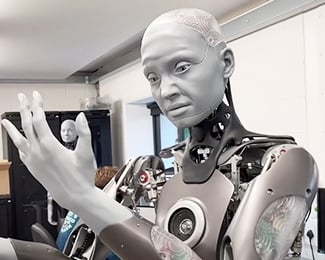 The company’s website touts its machine as The Future Face of Robotics: “Multiply the power of artificial Intelligence with an artificial body. Ameca is the physical presence that brings your code to life. The most advanced lifelike humanoid you can use to develop and show off your greatest machine learning interactions. This robot is the digital interface to the real world.”
The company’s website touts its machine as The Future Face of Robotics: “Multiply the power of artificial Intelligence with an artificial body. Ameca is the physical presence that brings your code to life. The most advanced lifelike humanoid you can use to develop and show off your greatest machine learning interactions. This robot is the digital interface to the real world.”
The company offers its software of life-like expressions: smile, frown, wink, open and close its mouth, and to look around with “surprise or frustration or amusement” as a cyber-physical platform. Ameca enables AI developers to then graft their own software onto the robot’s base platform.
Like the company’s other robots, Mesmer and RoboThespian, Ameca is also painted with colors meant to mimic human skin and hair.
Will Jackson, founder of Engineered Arts, said in an interview that Ameca is the result of over “15 years' worth of research and development...to develop robots that are able to interact in human-like ways, with humans.”
Ameca will be in attendance at CES2022, in January.
Google’s “Everyday Robot Project”
In 2013, Google bought eight robot companies, spent millions of dollars trying to make something of them in its Google X Lab; but didn’t Then X Lab went very silent until the 2019 debut of its trash-picking robots.
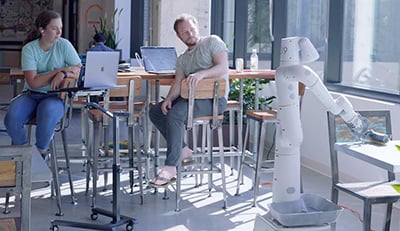 Zoom ahead a couple of years, and the trash pickers are now into cleaning (see side-by-side comparison photos). As the Verge commented: “What does Google’s parent company Alphabet want with robots? Well, it would like them to clean up around the office, for a start…Though the machines are still very much a work in progress”
Zoom ahead a couple of years, and the trash pickers are now into cleaning (see side-by-side comparison photos). As the Verge commented: “What does Google’s parent company Alphabet want with robots? Well, it would like them to clean up around the office, for a start…Though the machines are still very much a work in progress”
Alphabet, the parent of Google, announced that it’s Everyday Robot Project — a team within its experimental X labs dedicated to creating “a general-purpose learning robot” — has moved some of its prototype machines [about 100] out of the lab and into Google’s Bay Area campuses to carry out some light custodial tasks.”
As the X Lab’s website explains it: “The Everyday Robot Project is developing a general-purpose learning robot that can operate autonomously in unstructured environments.”
And more from Google: “The same robot that sorts trash can now be equipped with a squeegee to wipe tables and use the same gripper that grasps cups can learn to open doors.”
Here’s hoping that after nearly a decade of robot development within Google that something, maybe far from earthshaking, could present the marketplace with a worthwhile robot worker.

Drones with birds’ feet conserve energy
For all of their interesting and useful capabilities, drones cannot conserve energy while hovering, by grabbing onto something like a tree branch to perch awhile, as maybe they would need to do in a search and rescue mission.
Until now, that is.
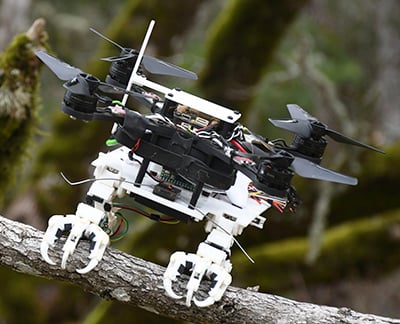 Stanford engineers have recently developed a quadcopter with two, birdlike legs that permit it to land most anywhere.
Stanford engineers have recently developed a quadcopter with two, birdlike legs that permit it to land most anywhere.
David Lentink and Will Roderick, Stanford research engineers involved in the drone’s development, studied how birds actually accomplish landing on really complex surfaces before building their quadcopter.
“Despite undergoing 190 trials…the bird bot saw little wear to its structural integrity…and could repeatedly perch without much computation from the bot’s controls.”
“Because the legs are adaptable enough to land the robot, there was no need for artificial intelligence, Lentink explained. “This leaves room for flight, observation, and other motions to be programmed into the landing features if they were to be added to more complex machines in the future.”
The bird bot’s feet can bend at two joints, which enables it to grasp a branch by bending at the first joint before the second, like bending your wrist and then fingers to grab something. The legs also bend upon contact with the branch to absorb the shock, which in turn creates tension for the feet and toes to curl around the branch.
Cancer-fighting microrobots…with mouths!
Chemotherapy in treating cancer can be very successful, but its side effects can be devastating for the rest of the body. However, if drugs could be delivered directly to the cancer cells, it would vastly mitigate any side effects.
 Chen Xin, Dongdong Jin, Yanlei Hu et al, from China’s Hefei University, took up the challenge, reporting their success with microrobots in the American Chemical Society’s journal Nano.
Chen Xin, Dongdong Jin, Yanlei Hu et al, from China’s Hefei University, took up the challenge, reporting their success with microrobots in the American Chemical Society’s journal Nano.
Because cancerous tumors exist only in acidic microenvironments, the team got the idea to have their microrobots change shape and open their mouths to deliver drugs to the tumor when encountering the acidic microenvironment at a tumor site.
“The team built 4D printed microrobots in the shape of a crab, butterfly or fish using a pH-responsive hydrogel. Then, they made the microrobots magnetic by placing them in a suspension of iron oxide nanoparticles.”
Guided with magnets to cancer cells, where a pH change triggers them to open their mouths, the researchers showed that the microrobots successfully released their chemotherapy drugs to successfully kill tumor cells.


Leave a comment